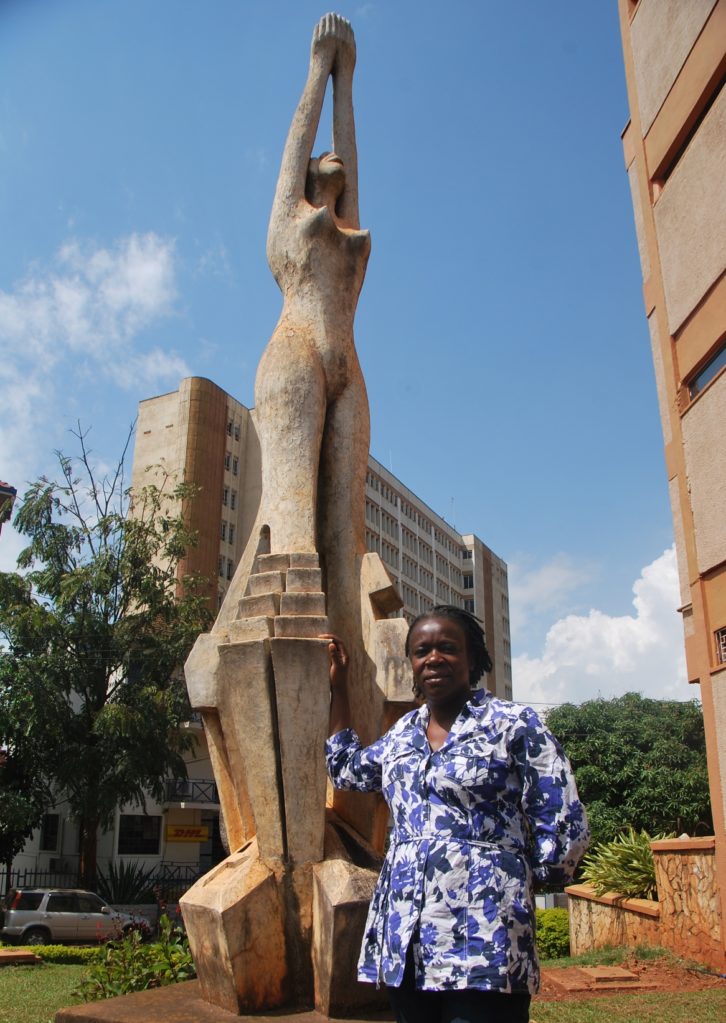Kirumira Rose Namubiru is one of Uganda’s busiest and most well-known sculptors, specializing in the human form. Yet, when we meet her, Namubiru, a doctorate and senior lecturer at the School of Industrial and Fine Arts at Makerere University in Uganda’s capital Kampala, says recognition did not come easily.
Her very first outdoor exhibit was marred by controversy. Namubiru had been assigned by the United Nations Development Programme (UNDP) in 1987 to create two sculptures for their offices in Kampala. She cast what later became the famous Mother Uganda and UNDP sculptures.
Mother Uganda, a semi-nude sculpture of a black woman, was hugely criticized because people thought it depicted nudism and sexism – two topics taboo in most African cultures.
The controversy was widely covered in the local press.

Loading...
“I was just starting [out]. I got many threats. I didn’t know what to do or say, but my professor, the late Musango Gwantamu, stood by me. I explained that the sculpture wasn’t naked but a portrayal of the beauty of the motherland [of] Uganda, in [the] shape of a woman,” says Namubiru.
In the end, the dust settled and the sculpture stands till today. Namubiru jokes she now wishes she had made her work even more beautiful.
“I could have rounded the bust a little bit more and given it more hips,” she says. More importantly, Namubiru says she was encouraged to carry on as she realized her work could create an impact.
Namubiru’s sculptures are displayed around the world, most notably: The Page (1995) in Winnipeg, Canada; Ambassador (1999) in the US, Omumbejja (1997-2010) in Denmark, and Friendship (2000) in Changchun, China.
She built her reputation fusing traditional visual art skills, techniques and knowledge with style, tending towards the decorative.
Her original exposure outside Makerere was at the international artists’ workshop at the Thapong Visual Arts Centre in Botswana in 1994. Soon, she felt the need to organize exhibitions in Uganda similar to those she had attended in other countries. In 1998, she successfully organized the first-ever international artists’ workshop in Uganda.
Namubiru foresees a brighter future for female sculptors due to growing synergies among artists globally. She however calls for more funding and enforcement of policies targeting art.
Art For AIDS
A senior lecturer at the School of Industrial and Fine Arts at Makerere University, Lilian Mary Nabulime created sculptures on a wide range of themes before switching her focus to HIV/AIDS during her PhD studies at the University of Newcastle-upon-Tyne. The reasons were also personal.
Traumatized by the suffering of her husband and other relatives who had the condition, she felt the need to initiate a campaign that could spread awareness about the disease so prevalent in her home country Uganda.
Using translucent soap bars, Nabulime sculpted male and female genitalia depicting the lives and experiences of women living with HIV/AIDS in Uganda. Over the years, these creations have become important tools in awareness campaigns.
Nabulime’s models have created a sculptural language that transcends literacy barriers and ethnic differences and divides to reach the largest possible audience. During her master’s degree in 1992, curvy tree stumps were her trademark but she also fashioned installations from the roots of trees.

“One time there was a heavy storm that brought down huge trees at the university. The exposed roots inspired me to get into root sculpturing. I made quite a number of them, some in huge sizes,” says Nabulime.
She sought assistance from the German Cultural Society for her first exhibition, held at Sheraton Kampala Hotel, along were two other male painters. Although she only sold a handful of pieces, the exhibition brought numerous opportunities. She went on to participate in over 50 exhibitions and hundreds of workshops in Africa and beyond.
Loading...
